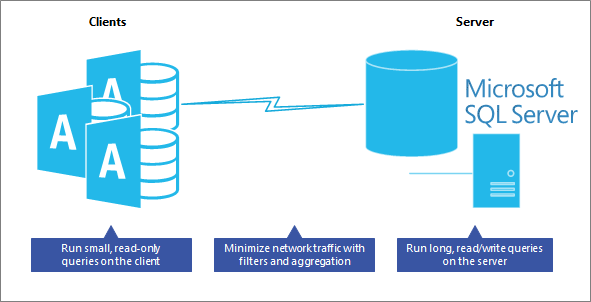Software is always changing and improving, and we need to keep up with it. One of the most important ways to do that is to modernize our old systems and connect them to the new possibilities of business excellence. That’s why we are going to explore how to migrate from MS to SQL server in this article. This is not just a choice, but a necessity for any business that wants to stay ahead of the competition.
The Limitations of MS Access
Cast your mind back to the days when MS Access reigned as the go-to solution for data management. While it held its ground admirably, it has outgrown its comfort zone. The restrictions on data size are palpable, and enterprises wrestling with expanding datasets understand the frustration.
According to Cohesity, data fragmentation (this is a feature of MS Access) is the distribution of data across different systems and locations, preventing organizations from getting full value from their data. When data is scattered across many different silos, whether in clouds or on-premises, this fragmentation causes computer capacity to be used inefficiently. Visibility of your data, which is critical for environments that must adhere to regulatory compliance, also becomes difficult. That’s what raises cost, performance, risk, and management issues.
The Capabilities of SQL Server
Stepping onto the stage is SQL Server, a heavyweight contender in the realm of database management. It transcends the realm of mere data storage — instead, it serves as a catalyst for unleashing the full spectrum of its capabilities. With SQL Server, what might initially appear as the challenge of data handling transforms into a strategic strength.
In the context of Microsoft’s innovative journey, SQL Server shines as an exemplar of progress. This platform offers a dynamic array of choices, encompassing development languages, data types, adaptable environments spanning on-premises and cloud domains, and versatile operating systems. Noteworthy highlights within this tapestry of enhancements encompass:
- Azure Synapse Link for SQL in SQL Server 2022 enables near-real-time operational data analytics, bridging analysis and action.
- SQL Server integrates with S3 compatible object storage, allowing easy querying of parquet files using T-SQL for advanced data exploration.
- Data Virtualization lets SQL Server query diverse data sources, enhancing decision-making within the platform.
- Azure SQL Managed Instance Link connects SQL Server instances with Azure SQL Managed Instance, uniting on-premises and cloud environments.
- Standalone Availability Group establishes self-managing Always On availability groups, including standalone system databases for increased self-sufficiency.
In sum, SQL Server goes beyond a typical database. It turns data management into a strategic asset, enhancing modern businesses with extraordinary capabilities.
- Business Agility through Data Centralization
Imagine the allure of centralization — a dream shared by business leaders everywhere. SQL Server has the power to transform this dream into reality. It’s about having one definitive source of truth, where data communicates with unwavering clarity. Companies are adopting this transformation to SQL Server from MS Access, which has resulted in simplified operations and informed decision-making.
- Enhanced Security and Compliance
Security stands tall as a pillar of trust in the digital realm. However, MS Access, while serving its purpose, falters in multi-user scenarios. Here’s where SQL Server steps up with an impenetrable shield of encryption, ensuring data confidentiality. Think of the healthcare sector, where safeguarding patient information is paramount. SQL Server’s security features provide assurance to both patients and professionals.
- Scalability for Growth
Picture a fledgling startup teeming with potential. MS Access seemed like a logical choice until growth came knocking. Suddenly, the system buckled under the weight of burgeoning data. Scaling became an insurmountable hurdle. Enter SQL Server, equipped to gracefully handle expanding datasets without compromising performance. This transition allows startups to think ambitiously without being burdened by the limitations of data.
- Improved Performance for Unleashed Productivity
Think back to the times when complex queries left MS Access users scratching their heads. Languid response times were par for the course. Now imagine a shift to SQL Server as if pressing a turbo button. Queries optimize, responses accelerate, and productivity takes flight. ModLogix customers are particularly highlighting this transformation, with reports that once-demanded hours now materialize in seconds after migrating to SQL Server from MS Access.
- Efficient Development and Easy Maintenance
Applications, like businesses, evolve. Complex MS Access apps become intricate, demanding maintenance. SQL Server changes the game with streamlined development, Visual Studio tools, and Microsoft integration. Application management becomes organized.
- Cost-Effectiveness and Long-Term Gains
Speak in numbers — the language of business. MS Access seems affordable, but accumulates hidden maintenance costs. SQL Server shifts the balance. Initial migration costs give way to clear long-term advantages. Maintenance decreases, ROI consistently rises.
Generally, migrating from MS Access to SQL Server’s cost and duration vary based on factors like database size, complexity, customization needs, resources, expertise, and potential challenges. Usually, a migration costs $10,000 to $100,000 and takes 3 to 12 months.
Practical Steps for Seamless Migration
The journey from MS Access to SQL Server is neither a leap nor a plunge — it’s a methodical voyage. It commences with data assessment, cascades into schema design, unfurls with data migration, refines with application reengineering, and culminates in rigorous testing. This expedition is smoother with the guidance of experts like ModLogix, who bring to the table a wealth of expertise in legacy software modernization. Their involvement guarantees a migration that’s not just triumphant but transformative.
| Migration Step | Description |
| Data Assessment | Begin with a comprehensive analysis of existing data structures and requirements. |
| Schema Design | Craft a robust schema design that aligns with the nuances of SQL Server’s capabilities. |
| Data Migration | Execute a systematic plan to transfer data from MS Access to SQL Server without disruptions. |
| Application Reengineering | Refactor applications to fully harness the potential of SQL Server’s advanced features. |
| Rigorous Testing | Thoroughly test the migrated system to ensure optimal performance and functionality. |
| Expert Guidance | Seek the assistance of professionals like ModLogix, proficient in legacy software modernization. |
| Transformational Impact | Leverage the expertise experience of professionals in the field for a migration that not only succeeds but revolutionizes operations. |
The table summarizes key steps for a seamless MS Access to SQL Server migration, highlighting their importance and the crucial role of expert guidance, particularly from a professional team, in ensuring a successful transition.
Conclusion and Synthesis
Moving from MS Access to SQL Server reveals vast possibilities. By embracing this change, organizations not only migrate their data, but they also migrate their potential for growth, innovation, and lasting success. In the face of constant change, the journey to SQL Server from Access becomes a defining choice, signaling a commitment to embrace the future of business. Evolution is constant, and the future is inviting.








